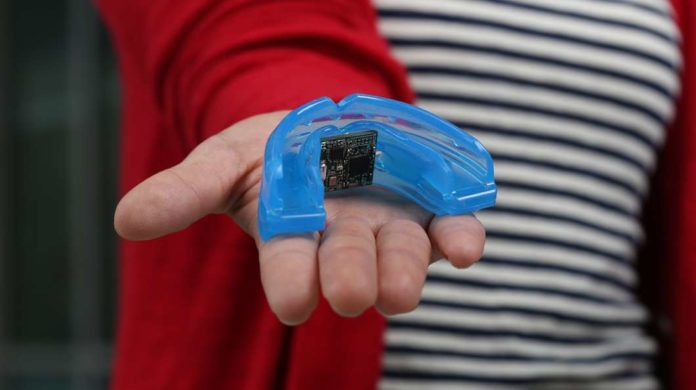
The electronics in the current prototype could be a bit of a mouthful, but a more compact version is in the works (Credit: UC San Diego Jacobs School of Engineering)
We’ve already heard about an electronics-packing mouthguard that can be used to detect serious impacts to the head. Now, scientists at the University of California, San Diego have developed one that could provide continuous readings of users’ health markers including lactate, cortisol and uric acid. It may be used to monitor the well-being of people such as diabetics, to track the performance of athletes, or to detect stress in soldiers.
Developed by a team led by professors Joseph Wang and Patrick Mercier, the current version of the mouth guard is designed specifically to check wearers’ uric acid levels, which are affected by conditions including diabetes and gout.
Within a circuit board about the size of a penny, the device contains a screen-printed sensor that incorporates silver, Prussian blue ink and an enzyme known as uricase. When the uricase is exposed to uric acid in the user’s saliva, it reacts by forming hydrogen peroxide, which subsequently reacts with the ink. This in turn produces an electrical signal, which is digitized and then wirelessly transmitted to a smartphone or tablet for analysis.
So far the mouth guard has proven accurate at detecting high uric acid levels in saliva samples from a patient with hyperuricemia, a condition which produces excessive uric acid in the bloodstream. It was also able to detect that those levels had gone down, when the test subject took uric acid-lowering medication.
Previously, the only way of monitoring those levels would have been through the drawing of multiple blood samples, and the patient would need to wait for symptoms to develop before knowing that they needed to take the medication.
In the lab tests, however, the saliva samples were simply spread on the sensor – the electronics need to be further miniaturized before the mouth guard can comfortably be worn continuously in a person’s mouth. It is hoped that a wearable version should be complete within a year.
A paper on the research was recently published in the journal Biosensors and Bioelectronics.
